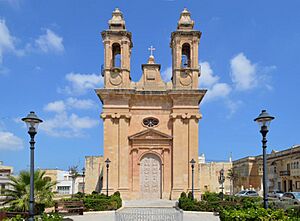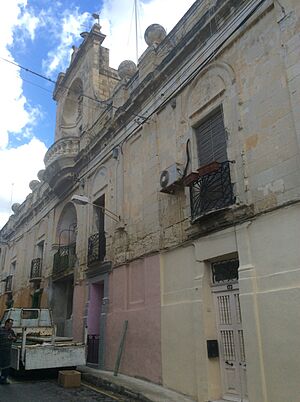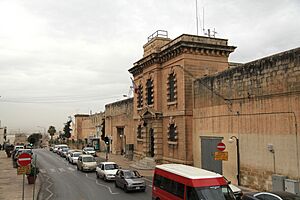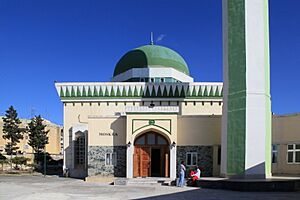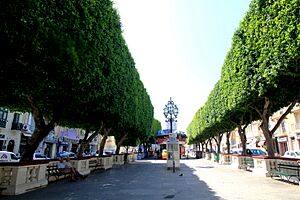Paola, Malta facts for kids
Quick facts for kids
Paola
Raħal Ġdid
Pawla
Casal Paola, Casal Nuovo |
|||
|---|---|---|---|
|
Local council
|
|||

Antoine de Paule Square and the Basilica of Christ the King
|
|||
|
|||
 |
|||
| Country | |||
| Region | South Eastern Region | ||
| District | Southern Harbour District | ||
| Founded | 1626 | ||
| Founded by | Antoine de Paule | ||
| Borders | Cospicua, Fgura, Luqa, Marsa, Santa Luċija, Tarxien | ||
| Area | |||
| • Total | 2.5 km2 (1.0 sq mi) | ||
| Population | |||
| • Total | 8,706 | ||
| • Density | 3,480/km2 (9,020/sq mi) | ||
| Demonyms | Paolites Pawlist (m), Pawlista (f), Pawlisti (pl) |
||
| Time zone | UTC+1 (CET) | ||
| • Summer (DST) | UTC+2 (CEST) | ||
| Postal code |
PLA
|
||
| Dialing code | 356 | ||
| ISO 3166 code | MT-39 | ||
| Patron saint | Christ the King; Our Lady of Lourdes | ||
| Day of festa | Last Sunday of July; 1st Sunday after 15 August | ||
| Website | Official website: http://www.paolalocalcouncil.org/ | ||
Paola (also called Raħal Ġdid in Maltese or Casal Nuovo in Italian, both meaning "New Town") is a busy town in the South Eastern Region of Malta. In 2019, about 8,700 people lived there. It's a major shopping area in the Southern Harbour, located about 5 kilometers from the capital city, Valletta. Paola is right next to Tarxien and Fgura, forming one big urban area. The town got its name from Grand Master Antoine de Paule, who started building it in 1626.
Paola is famous for several important places. These include the Hypogeum of Ħal-Saflieni, an amazing underground ancient site, and the Basilica of Christ the King, which is the biggest church in Malta. You can also visit Antoine de Paule Square, which has many shops. The town is known for its Good Friday procession and its football team, Hibernians FC. Paola is also home to the Mariam Al-Batool Mosque, the only mosque in Malta, and an Islamic Cultural Centre. The country's main prison, Corradino prison, and its largest cemetery, the Addolorata Cemetery, are also located here.
The town has two main churches. One is for Christ the King, and its feast is celebrated on the last Sunday of July. The other is for Our Lady of Lourdes, celebrated on the first Sunday after August 17. There's also a smaller Franciscan church dedicated to Saint Anthony. The oldest church in Paola is St. Ubaldesca Church, which was the first parish church. It was restored in 2008. Another historical spot is Villa Perellos, named after Grand Master Ramon Perellos y Roccaful.
Contents
History of Paola
Ancient Times
Even though Paola was officially founded in the 1600s, people lived here much, much earlier. Many ancient stone structures and remains from prehistoric times have been found in the area.
The Ħal Saflieni Hypogeum
The Hypogeum of Ħal-Saflieni is a very special place. It's so important that UNESCO has named it a World Heritage Site. Imagine a huge set of rooms carved out of soft limestone, about 11 meters underground! It seems people used it as a burial site and also as a temple. Ancient people carved this amazing place using only tools like antlers and stone picks, often in dim light.
The Hypogeum has three levels. The top level looks like older rock-cut tombs found elsewhere in Malta. The middle level was carved between 3800 and 2500 B.C. It has many different chambers. When archaeologists explored it, they found many small statues, charms, figurines, and vases. The most famous discovery is the "Sleeping Lady," a reclining figurine that might show eternal sleep. You can see it at the National Museum of Archaeology in Valletta.
The Kordin Temples
The Kordin Temples were another set of ancient temples located on a high area overlooking the Grand Harbour.
- Kordin I and II: These temples were explored by archaeologists a long time ago. Sadly, they were badly damaged during World War II bombings and by new buildings constructed later. Not much is left of them today.
- Kordin III: This is the only Kordin temple still standing. It has a special design with three curved rooms. It's unique because its front area has a stone floor, and so does the path leading into the main court. One interesting feature is a long stone "trough" with seven deep grooves. Experts believe it was used to grind corn, showing how ancient people used this space. Kordin III is protected inside a walled area next to the Church of St. Anthony.
The Order of St. John
Paola is named after Grand Master Antoine de Paule. He was the leader of the Order of St. John and started building the town in 1626. De Paule became Grand Master in 1623 when he was 71 years old. To help with Malta's growing population, he decided to create a new town on a hill called Tal-Għerien (meaning "of the caves"). It was first called Casal Nuovo ("new town") because it was founded under the Order's rule. Later, it was named Casal Paola after the Grand Master's family name. People still call it Paola today.
To encourage people to move to Paola, Grand Master de Paule even helped families with their debts if they settled there. He also had a church built in the town, dedicated to St. Ubaldesca, who was a Sister of the Order of St. John. This church became the first parish church of Paola. The Pope gave permission for this church to be built in 1629. The Grand Master himself laid the first stone of the church on August 25, 1630, in a big ceremony.
British and Modern Times
At the beginning of British rule, Paola was almost empty because of malaria from nearby marshlands. These marshes were drained, which helped the population and wealth of Paola grow again.
In the 1840s, the British built the Corradino prison in Paola. It was designed like a famous prison in London. Today, Corradino is still Malta's main prison, even though it's now surrounded by the town.
From 1862 to 1868, the Addolorata Cemetery was built in Paola. It's the main burial ground in Malta. The cemetery and its chapel were designed in a beautiful neo-gothic style. It opened in 1869, and the first burial happened in 1872. The cemetery has many old tombs and statues.
From 1905 to 1929, Paola Square even had a stop for the Malta Tramways, which connected Valletta to Cospicua.
The St. Ubaldesca Church was made bigger in 1900 as more people moved to Paola. In 1910, Paola became its own parish. A new, much larger church, the Basilica of Christ the King, was built in the town's main square, Antoine de Paule Square. It started being used in 1936 and was officially dedicated in 1967. This church has been restored and is beautifully decorated inside. In 2020, it was given the special title of a minor basilica.
Paola is also home to the Mariam Al-Batool Mosque, which is the only mosque in Malta. Its first stone was laid in 1978, and it opened in 1982. The mosque complex also includes a school, an Islamic Cultural Centre, and a cemetery.
For many years, until 2018, Paola Square (Pjazza Antoine de Paole) had a central walking area with a kiosk and shady trees. In 2015, the government started a project to improve the square. This project involved removing all the old, mature trees. The reason given was that their roots were damaging underground pipes and their sap was making the ground dirty. The work took a long time, and the square wasn't fully made into a walking-only area because local shop owners wanted cars to still be able to pass. Some residents were unhappy that the big trees were replaced with small saplings that didn't offer much shade.
Population Changes
Paola's population has changed over the years, as shown in this chart.

Band Clubs
- Soċjeta' Filarmonika 11 ta' Frar- Madonna ta' Lourdes
- De Paule Philharmonic Society Christ the King Band (Is-Soċjetà Filarmonika De Paule Banda Kristu Re) (tal-Ħomor)
- Christ the King Band Club (Ghaqda Socjali w Muzikali Kristu Sultan Banda Paola) (tal-Ħodor)
Areas in Paola
- Għajn Dwieli
- Il-Qortin
- Kordin (Corradino)
- Moll il-Faħam
- L-Ordinanza
- Ras Ħanżir
- Tal-Borġ
- Tax-Xewk
Main Roads in Paola
- Pjazza Antone De Paule (Paola Square)
- Telgħat Raħal Ġdid (Paola Hill)
- Triq Bormla (Cospicua Road)
- Triq Għajn Dwieli (Għajn Dwieli Road)
- Triq Ħal Luqa (Luqa Road)
- Triq Ħal Tarxien (Tarxien Road)
- Triq Ħaż-Żabbar (Żabbar Road)
- Vjal Kristu Re (Christ the King Avenue) - formerly called Triq il-Belt Valletta (Valletta Road)
- Triq il-Perit Dom Mintoff (Dom Mintoff Road) - formerly called Triq Kordin (Corradino Road)
- Triq l-Isqof Buhagiar (Bishop Buhagiar Street)
- Triq Lampuka (Lampuka Street)
- Triq Sammat (Sammat Street)
- Vjal Santa Luċija (Santa Lucia Avenue)
- Vjal Sir Pawlu Boffa (Sir Paul Boffa Avenue)
- Triq Palma (Palm Street)
- Triq l-Arkata (Arcade Street)
Famous People from Paola
- Bernard Grech, a leader in politics, was born here.
- Sir Paul Boffa (1890–1962), who was a Prime Minister, lived in Paola.
- Ino Bonello, an international movie art director.
- Chris Fearne, the Deputy Prime Minister and Minister for Health.
- Immanuel Mifsud, an author who won the European Union Prize for Literature in 2011.
Twin Towns
Paola has "twin town" friendships with:





